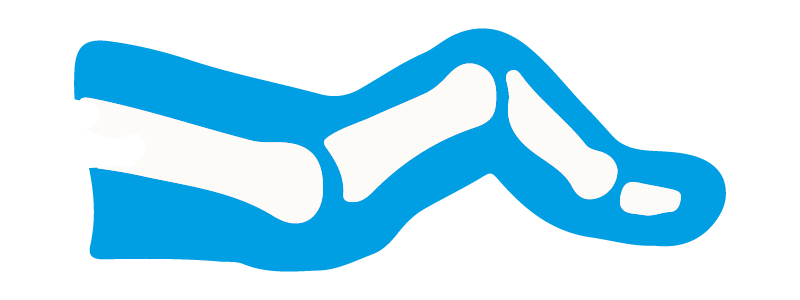
Lesser Toe Amputation
What is Lesser Toe Amputation?
Lesser toe amputation is an operation to surgically remove the problematic toe(s).
When is it necessary?
Surgery is usually recommended if you are experiencing pain and footwear limitation / disability along with:
- Prominent toe joints
- Callus and corns to the top side or end of toe
- Callus or corn on the ball of foot
- Recurring blisters or ulcers
- Difficulty with shoe fit despite wearing sensible footwear
Surgery can also be an option for common types of deformities which affect the lesser toes, including Hammer toe, Claw toe, Mallet toe or Cross over toe.

Mallet toe

Hammer toe

Claw toe

Cross-over toe
What does the operation involve?
An incision (cut) is made around the toe at the level of the amputation. You will have stitches put in which will remain in place for two to three weeks. There is no bone healing required. You do not usually need to have a plaster cast. You will have a post-operative shoe and often crutches.
Can this be done as a day case operation?
The operation can be done as a day case if you are medically fit, have someone who can collect you and look after you after the operation and you are comfortable afterwards. However, if you have other medical problems such as diabetes, asthma or high blood pressure, you may need to stay overnight after your surgery. You must stay overnight to avoid complications if there is no one to collect and look after you. If you are having many toes operated on, especially if both feet are involved, you may need to stay in for a day to allow swelling to go down. You also may need to attend the preoperative assessment clinic 2-6 weeks before your surgery. This will be discussed with you in clinic when you are offered surgery.
Will I have to go to sleep (have a general anaesthetic)?
The operation can be done under local anaesthetic (awake) or general anaesthetic (asleep). Your anaesthetist will advise you about the best choice of anaesthetic for you. In addition, local anaesthetic may be injected into your leg or foot while you are asleep to reduce the pain after the operation even if you go to sleep for the surgery. You will also be given painkilling tablets as required.
Rehab and recovery after surgery
You can arrange to return if you are having any problems. Please note if a complication arises, recovery may be delayed. A toe spacer to maintain the position of the remaining toes is recommended, this will be provided.
Two to four days
- You must rest completely for two to four days with your foot elevated just above hip level.
- You may be advised to keep the circulation going by gently drawing circles in the air or wiggling your toes.
- If you have been given crutches you must use them in the way shown.
- You may be able to bear a little weight on the foot carefully using just the heel.
- You can get about a little more after three to four days.
Seven days
- You may need to attend for your foot to be checked in 1 week and re-dressed.
2-3 weeks
- You will usually attend clinic 2-3 weeks after the surgery for removal of stitches.
- You should no longer need the bandage and you should be able to get around without crutches.
- Your foot will still be quite swollen, but you should be able to get a roomy shoe on.
- Provided that the wound is healed you should be able to get the foot wet.
- You will be advised on a gradual return to activity and may also be advised on scar care.
- By the third week, your foot starts to return to normal and you can return to shoes.
- The foot may still be quite swollen especially at the end of the day.
3-4 weeks
Depending on your job, you may be able to return to work.
3 months
You may be contacted about 3 months later to check all is well.
Returning to work
This will depend on the job you do and the speed of your recovery. We usually recommend 3 to 4 weeks. If in doubt, please discuss this with a member of the team.
When you can resume normal activity
Whilst you can resume normal activity, sport should be avoided until the wound is fully healed. You may return to driving if you can perform an emergency stop. You must check with your insurance company before driving again.
What are the risks?
- The wounds usually heal quickly, but occasionally these can bleed, become infected or need antibiotics
- Development / deterioration of a bunion
- Crowding / deformity of remaining toes
- Increased pressure to remaining toes
- Nerve damage and pain
- Excess and prolonged pain (Chronic Regional Pain Syndrome - CRPS)
General and common risks with most surgical procedures
There are general risks with any operation that include blood clots (Deep Vein Thrombosis & Pulmonary Embolism), anaesthetic complications and tourniquet complications.
How to reduce your risks and improve your health and wellbeing
Patients that have a healthy diet, regular exercise and refrain from smoking prior to surgery are more likely to experience a quicker and better recovery and may also have a more successful outcome with their surgery.
If you have any concerns about your general health and well-being (diet, exercise, smoking cessation) you are encouraged to discuss this with your GP, who will be able to provide advice on the options available to you.
Alternative non-surgical treatments
Non-surgical treatment usually focuses on symptom management such as:
- Activity modification
- Correct fitting or accommodative footwear
- Use of protective and cushioning shields, toe splints, strapping and or orthoses / insoles
- Using painkillers
Please talk to your medical team about all the options available to you.